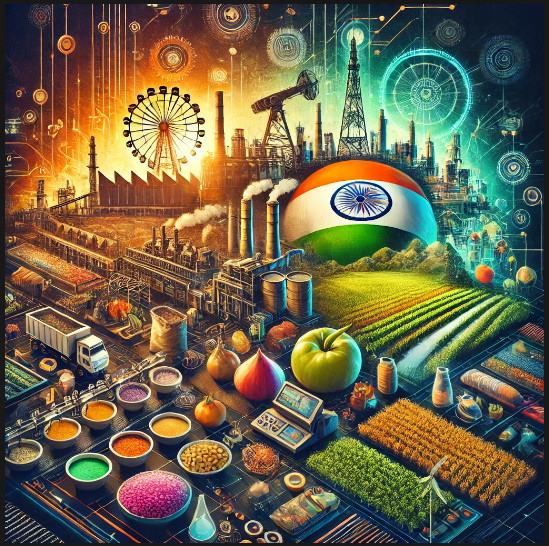Introduction
The food processing industry plays a crucial role in a nation’s economy by reducing agricultural wastage, increasing value addition, generating employment, and ensuring food security. In developed countries like the United States, Germany, and Japan, the food processing sector has evolved into a high-tech industry, leveraging automation, stringent quality control, and robust supply chain infrastructure. However, in India, despite being one of the largest producers of food globally, the food processing industry has not grown at the same pace as developed countries.
India has immense potential in food processing, given its diverse agricultural base, growing middle-class consumer demand, and increasing export opportunities. However, the sector faces several roadblocks, including inadequate infrastructure, policy bottlenecks, fragmented supply chains, and low technological adoption. This article explores the challenges, comparative analysis, and growth potential of India’s food processing industry vis-à-vis developed nations.
Comparative Analysis: Indian vs. Developed Nations’ Food Processing Industry
1. Contribution to GDP and Employment
- In developed nations, food processing contributes 15-20% to GDP, whereas in India, it accounts for only 10-12% of GDP.
- The organized sector in developed countries dominates the food processing industry, whereas in India, nearly 80% of the industry remains unorganized, with small and medium enterprises (SMEs) playing a significant role.
- Employment generation in the Indian food processing sector is high but remains largely informal, unlike developed nations, where the industry provides highly skilled employment.
2. Infrastructure and Supply Chain Efficiency
- Developed countries have well-established cold storage facilities, advanced logistics, and supply chain integration.
- In contrast, India faces significant post-harvest losses due to inadequate storage, lack of refrigerated transport, and inefficient logistics.
- The farm-to-market linkage is well-structured in developed countries, while in India, farmers face difficulties in direct access to processing units.
3. Technology and Automation
- Automation and AI-driven food processing are common in developed nations, ensuring high productivity and quality.
- In India, small-scale units rely on traditional methods, and the adoption of modern processing technology is limited due to high costs.
- Developed nations extensively use food safety tracking systems, while India still struggles with quality control and food safety norms.
4. Policy and Government Support
- Developed nations have strong policy frameworks supporting the food industry through incentives, subsidies, and research.
- India has initiatives like Pradhan Mantri Kisan Sampada Yojana (PMKSY) and Mega Food Parks Scheme, but their implementation remains slow and fragmented.
- Regulatory challenges such as delays in approvals, high compliance costs, and multiple regulations hinder India’s food processing sector.
Challenges Hindering Growth of India’s Food Processing Industry
1. Lack of Modern Infrastructure
- Insufficient cold storage and transportation facilities lead to high wastage of perishable goods.
- Poor logistics and supply chain management reduce efficiency and increase operational costs.
2. Fragmented Agricultural Supply Chain
- India’s agricultural supply chain is highly unorganized, with multiple intermediaries increasing costs and reducing farmers’ profits.
- Lack of direct linkage between farmers and food processors affects raw material procurement and pricing stability.
3. Low Investment in Research and Development (R&D)
- Developed nations invest heavily in food technology innovation, including alternative proteins, fortified foods, and sustainable packaging.
- India’s food processing industry lacks sufficient R&D funding, limiting innovation and value addition.
4. Regulatory Bottlenecks and Compliance Issues
- The Indian food industry faces multiple regulations from FSSAI, APEDA, and state-level authorities, leading to delays and increased costs.
- Stringent quality standards for exports limit global competitiveness.
- Frequent policy changes create an uncertain business environment.
5. Limited Access to Finance
- Small and medium food processing enterprises (SMEs) face difficulty in obtaining credit, hampering expansion and modernization.
- High-interest rates on loans make capital-intensive investment in food processing unfeasible.
6. Inadequate Skill Development
- Developed countries have well-established skill development programs for food processing professionals.
- India lacks formal training programs, leading to a shortage of skilled manpower in food technology and processing.
7. Low Export Competitiveness
- Indian processed foods face stiff competition in international markets due to high costs, inconsistent quality, and lack of branding.
- Developed nations have strong global supply chains, whereas India’s export infrastructure needs improvement.
Growth Potential and Future Roadmap for India’s Food Processing Industry
1. Strengthening Infrastructure and Supply Chain
- Investment in cold storage, logistics, and modern warehouses can significantly reduce wastage.
- Developing integrated food processing zones to enhance efficiency and competitiveness.
- Public-private partnerships (PPP) to boost infrastructure development.
2. Promoting Technological Adoption
- Encouraging automation, AI, and IoT in food processing units.
- Providing subsidies and incentives for modern machinery and technology adoption.
- Strengthening food safety compliance through blockchain and digital traceability.
3. Simplifying Regulations and Policies
- Creating a single-window clearance system to streamline approvals.
- Reducing regulatory burdens on SMEs to encourage entrepreneurship in food processing.
- Strengthening export promotion councils to enhance global market reach.
4. Boosting Financial Support and Investment
- Increasing availability of low-interest loans and credit guarantees for SMEs.
- Encouraging foreign direct investment (FDI) in food processing to bring in capital and expertise.
- Enhancing venture capital and startup funding for food-tech innovations.
5. Strengthening Farmer-Processor Linkages
- Promoting contract farming and direct farmer-producer linkages.
- Expanding National Agricultural Market (e-NAM) to provide better market access.
- Ensuring fair pricing mechanisms for raw material procurement.
6. Investing in R&D and Innovation
- Establishing food technology research institutes and innovation hubs.
- Encouraging startups in alternative proteins, organic foods, and nutraceuticals.
- Strengthening collaboration between industry and academia for product development.
7. Enhancing Export Potential
- Branding Indian processed foods in international markets.
- Improving packaging and adhering to global food quality standards.
- Expanding bilateral trade agreements to access newer markets.
Conclusion
India’s food processing industry has tremendous potential but lags behind developed countries due to infrastructure gaps, low technology adoption, policy challenges, and supply chain inefficiencies. To compete with developed nations, India must focus on modernizing infrastructure, easing regulations, investing in technology, and promoting exports.
Government initiatives like Mega Food Parks, PMKSY, and Atmanirbhar Bharat are steps in the right direction, but stronger implementation, increased private sector participation, and policy stability are required. With the right reforms, India can transform its food processing sector into a globally competitive industry, generating employment, reducing food wastage, and boosting economic growth.
By adopting a holistic approach, India can unlock the full potential of its food processing industry, ensuring a sustainable and prosperous future for all stakeholders.




